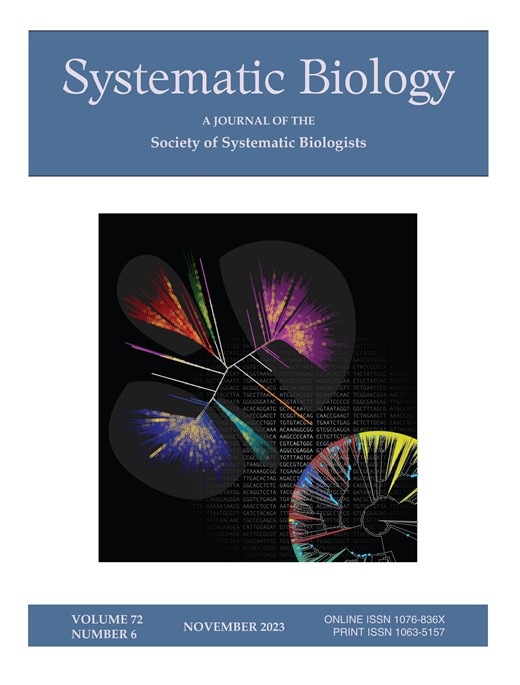巨多样性附睾兰早期分化谱系的关系、支持和冲突的核系统基因组学见解。
IF 5.7
1区 生物学
Q1 EVOLUTIONARY BIOLOGY
引用次数: 0
摘要
寄生虫提供了令人着迷的进化修饰的例子,同时对分类学提出了挑战。完全真菌异养的兰花就是一个例子,它们完全依赖真菌,占所有完全真菌异养植物物种的近一半。在构成巨多样性兰亚科(Epidendroideae)基础的8个部落中发现了大量的分枝异养谱系,这里称为早期分化的Epidendroideae (EDE)。迄今为止,EDE之间的关系一直存在问题。以前的分析在基于质体的分析中受到稀疏的分类单元采样,有限位点的弱支持或长分支吸引的影响。我们利用Angiosperms353位点,对EDE进行了迄今为止最全面的核系统基因组分析,并对支持、冲突、饱和和渗入进行了深入的探索。我们的研究首次纳入了所有8个EDE部落的系统基因组数据,其中包括26个EDE属中的22个。我们采用了一种新颖的方法,在个体基因座水平上选择最适合的混合模型配置,它比所有其他模型提供了更好的总体拟合,所需的参数更少,这对具有谱系特异性率异质性的进化支具有重要意义。我们恢复了除Neottieae外所有EDE部落的单系性强有力的支持,这被推断为paraphyletic。基于四重奏抽样分析,EDE部落间深层关系的信息含量普遍丰富,但整体支持度较弱。我们发现了饱和和假定渗滤的证据,以及两个推断的网状事件。我们得出的结论是,短的内部分支与快速多样化、不完整的谱系分类和假定的渗入相关,导致EDE部落之间的低一致性信号,强调了解决他们之间关系的持续困难。尽管如此,我们为天麻科的五个属提供了第一个强有力的系统发育假说,代表了已知的最大的完全真菌异养植物多样化。我们讨论了我们的发现,考虑到最近的系统基因组学研究,分类学,形态学和生物地理学的意义。本文章由计算机程序翻译,如有差异,请以英文原文为准。
Nuclear Phylogenomic Insights into Relationships, Support, and Conflict Among the Early Diverging Lineages of the Megadiverse Epidendroid Orchids.
Parasites present fascinating examples of evolutionary modification that simultaneously pose challenges for systematics. This is exemplified by fully mycoheterotrophic orchids, which are completely dependent on fungi, constituting nearly half of all fully mycoheterotrophic plant species. A large concentration of mycoheterotrophic lineages is found among the eight tribes comprising the base of the megadiverse orchid subfamily Epidendroideae, here referred to as the Early Diverging Epidendroideae (EDE). To date, relationships among the EDE have been problematic. Previous analyses have suffered from sparse taxon sampling, weak support from limited loci, or long branch attraction in plastid-based analyses. We conducted the most comprehensive nuclear phylogenomic analysis of the EDE to date, using Angiosperms353 loci, coalescent analyses, and deep exploration of support, conflict, saturation, and introgression. Our study is the first to include phylogenomic data from all eight EDE tribes, with 22 of 26 EDE genera represented. We took a novel approach selecting best-fit mixture model configurations at the individual locus level, which provided significantly better fit overall and required fewer parameters than all other models, with implications for clades characterized by lineage-specific rate heterogeneity. We recovered strong support for monophyly of all EDE tribes except for Neottieae, which were inferred to be paraphyletic. Based on quartet sampling analysis, information content was generally rich for deep relationships among the EDE tribes, but overall support was weak. We found evidence of saturation and putative introgression, with two inferred reticulation events. We conclude that short internal branches associated with rapid diversification, incomplete lineage sorting, and putative introgression resulted in low concordant signal among EDE tribes, underscoring the continued difficulty in resolving their relationships. Nonetheless, we provide the first strongly supported phylogenetic hypothesis for the five genera of Gastrodieae, representing the largest known diversification of fully mycoheterotrophic plants. We discuss our findings considering recent phylogenomic studies, taxonomy, morphology, and biogeographic implications.
求助全文
通过发布文献求助,成功后即可免费获取论文全文。
去求助
来源期刊

Systematic Biology
生物-进化生物学
CiteScore
13.00
自引率
7.70%
发文量
70
审稿时长
6-12 weeks
期刊介绍:
Systematic Biology is the bimonthly journal of the Society of Systematic Biologists. Papers for the journal are original contributions to the theory, principles, and methods of systematics as well as phylogeny, evolution, morphology, biogeography, paleontology, genetics, and the classification of all living things. A Points of View section offers a forum for discussion, while book reviews and announcements of general interest are also featured.
 求助内容:
求助内容: 应助结果提醒方式:
应助结果提醒方式:


